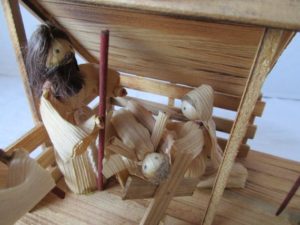 I am grateful to Chuck Winkler for having invited me to lead a session on “How We See Jesus” at the Men’s retreat at Camp Mingus last month. It was a beautiful setting and we all learned so much from each other. To begin, I asked participants to consider some of their earliest or childhood
I am grateful to Chuck Winkler for having invited me to lead a session on “How We See Jesus” at the Men’s retreat at Camp Mingus last month. It was a beautiful setting and we all learned so much from each other. To begin, I asked participants to consider some of their earliest or childhood
images of Jesus: maybe a picture, sculpture, or song. For me, it was a small crèche my mom had brought back from Germany as a young adult. Mary, Joseph, and baby Jesus – crafted from dried corn husks. I remember as a boy my folks putting that simple nativity out each Christmas season. Now as an adult I’ve come to realize another layer of meaning around that simple piece of folk art, fashioned of discards – I mean, besides tamales, what else are corn husks good for?
Jesus had a heart for “the last, the lost, the least” – those often regarded by society as “outcasts,” even “refuse.” Stories of his birth hint at his own marginalization: Mary, an unwed mother, expectant in a most unconventional way; the Good News coming not to the learned and powerful but to (dirty) shepherds working the night shift; the babe of whose birth we sing born not in Rome but some backwater province of the empire, and laying in a cattle feed trough, not a castle.
It’s easy to sentimentalize Jesus, especially during this season when we celebrate his birth with dazzling lights, lovely Hallmark cards and entertaining Christmas pageants. That simple corn husk crèche reminds me of the earthy reality of the birth of an outcast-soon-to-be-refugee who would devote his life to helping all to see – powerful or vulnerable – that everyone is no less than a child of God!
Merry Christmas,
Pastor Jeff

